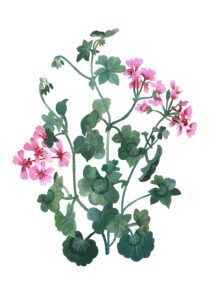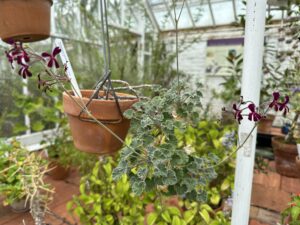 Influence of Lyman on Plath’s Poetry and Mental Health
Influence of Lyman on Plath’s Poetry and Mental Health
By Marge Poma Alarcon (’23)
Content Warning: this post contains gruesome language and references to death.
In an interview a year before her death, Sylvia Plath notes that her poetry has been heavily influenced by nature, which she described as an “absolute gift” to a young poet seeking to understand themselves and their world (Plath 1966: 171). I share Plath’s enthusiasm. My experience at Smith College has been heavily influenced by my interactions with the diverse plant collections at Lyman Conservatory. Plath, an American poet, novelist, and Smith alum, would’ve reaped the benefits of these same green spaces, as is evident in her journals, letters, and poetry. From her academic experience with botany in her first year at Smith, including through lab experiments with geraniums, Plath developed interspecies relationships that positively impacted her poetry and mental health.
In her first year at Smith, Plath completed a year-long course called Botany 11: General Botany. She worked directly with the geranium species known as the “silverleaf geranium” Pelargonium sidoides in the early weeks of Fall semester, conducting experiments focused on photosynthesis where she used bell jars that would later became the inspiration for her famous novel (Hoag n.d.). While her studies were primarily focused on English literature, she excelled in retaining and practicing botanical knowledge inside and outside the classroom, contributing to her exceptional skill of observation that is crucial for any good writer. In one journal entry from 1951, she seemed to be developing skills of description across botanical and human contexts. Recounting her botany professor observing a moss under a microscope, Plath comically blurs the lines between botanical description of the moss and human anatomical description of the professor (Plath 2000: 62):
[T]he slow tedium of rusty scalpels scraping clumsily on moss and blindly twirling lenses and knitting in between the languid sight of protococcus, and the dry factual volley of information from the loose fleshy mouth of the instructor. When he bends over the microscope before you, you trace the purple clusters of capillaries under the coarse porousness of his skin, striped with short bristly hairs and rutted where loose creases swing flabbily from his neck and jowls. “Here at the end of the pointer is a protonema with buds on it.” Here at the end of the pointer is a sick and squirming human intestine.
This entry serves as a starting point for her future works in which similar language and powerful descriptions of natural subjects are employed, making her distinct from other poets at the time as someone who was “born to write.”
After her Smith career, Plath periodically returned to think with geraniums in her poetry. Though using the more general term “geraniums,” it seems clear she is calling upon her knowledge of Pelargonium sidoides in her 1960 poem, “Leaving Early” (Plath 2018: 145):
Are those petals or leaves you’ve paired with them —
Those green-striped ovals of silver tissue?
The red geraniums I know.
Plath takes advantage of what she knows of the plant’s morphology, describing the variegated leaves of the silverleaf geranium, with its “green-striped ovals of silver tissue.” She continues to use the natural, blood-red colorations of the geranium flowers for comparison with a beating or stopped heart in “Poem for a Birthday” (1959) and “Mystic” (1963). While Plath was not necessarily considered a naturalist poet (Kerridge 2019), she uses the skills of one combined with her love of writing to produce work that considers the struggle between life and death, which will prove to have a positive impact on her mental health.

Pelargonium sidoides at Lyman Conservatory, 2023. Photo by Colin Hoag.
Mental health was a taboo topic during Plath’s time and unfortunately suffered immensely for it, but her interaction with nature eased the pain she felt from living in a patriarchal society, and her poetry led a charge to de-stigmatize discussions of mental health. Evident in letters she writes to her mother, “co-becoming” (Haraway 2008; see also Tsing 2011) with nearby floral organisms cultivate positive interactions with herself and with others. In one letter from October 1950, as she dreaded her fate of staying inside the greenhouse for her botany lab, she finds out that they were taking a field trip around campus: “Even though I find it tough going to learn technical names, I’ve got a curiosity about plant life which should help me over the rough spots.” She finishes this thought by saying that “life seems very rich on a day like this—especially because [she’s] rested & healthy” (Plath 2017: 198).
In contrast to common beliefs about Plath’s preoccupation with death and darkness, I contend that Plath celebrates life as she creates interspecies relationships with her natural surroundings. Plath had profound and important experiences at Lyman and they carry on for students such as myself. Rather than thinking of Plath as this luminary of a distant past, the transformative encounters that propelled her work and her sense of self are happening all around us—and for her, it started with a geranium like this one.
Works Cited
Haraway, Donna Jeanne. 2008. When Species Meet. Minneapolis, MN: University of Minnesota Press.
Hoag, Colin. N.d. “The Bell Jars: Smith College, Pelargonium sidoides, and Sylvia Plath’s Botanical Imagination.” Environmental Humanities in press.
Kerridge, Richard. 2019. “Plath and Nature.” In Sylvia Plath in Context, edited by Tracy Brain, 221–32. Cambridge: Cambridge University Press.
Plath, Sylvia. 1966. “Sylvia Plath.” In: The Poet Speaks: Interviews with Contemporary Poets Conducted by Hilary Morrish, Peter Orr, John Press and Ian Scott-Kilvert. Orr, Peter, ed. Pp. 167-172. London: Routledge.
———. 2000. The Unabridged Journals of Sylvia Plath. Edited by Karen V. Kukil. New York: Anchor.
———. 2017. The Letters of Sylvia Plath Volume 1: 1940-1956. Edited by Peter K. Steinberg and Karen V. Kukil. New York: Harper.
———. 2018. The Collected Poems. Reprint edition. New York: Harper Perennial Modern Classics.
Tsing, Anna. 2011. “Unruly Edges: Mushrooms as Companion Species.” Environmental Humanities 1: 141–54.